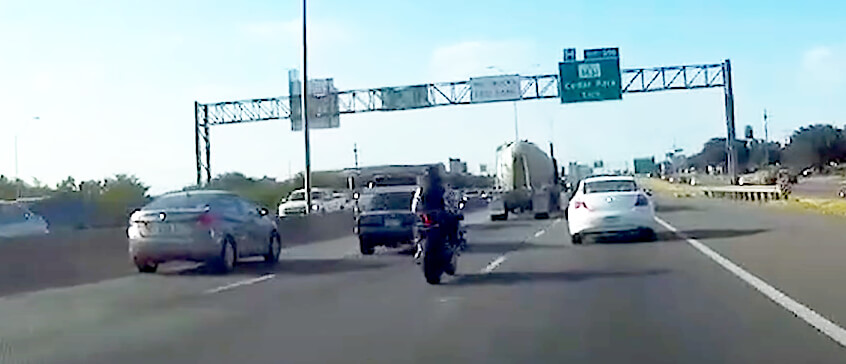Lane Splitting in Texas: What You Need To Know To Ride Safely And Legally.
Contents
- Lane Splitting in Texas: What You Need To Know To Ride Safely And Legally.
- What is lane splitting?
- Current state of lane-splitting laws in Texas
- Arguments for and against lane splitting
- Benefits of lane splitting for riders
- Dangers and risks of lane splitting
- How to safely implement lane splitting
- Lane-splitting etiquette
- Rider responsibility and accountability
- Consequences of violating lane-splitting laws
- How to stay informed and participate in the legislative process
Lane splitting is a practice that has been debated for years. It is riding a motorcycle between two lanes of stopped or slow-moving traffic. While some riders believe lane splitting is a safe and efficient way to get through traffic, others argue it is dangerous and illegal. In Texas, there has been a lot of confusion surrounding the legality of lane splitting. However, with the recent passing of a new law, lane splitting is now legal in certain situations. If you’re a motorcyclist in Texas, it’s important to understand the new lane-splitting law, how it affects you, and how to ride safely to avoid accidents. In this post, we’ll cover everything you need to know about the Texas lane-splitting law, including what it is, when it’s legal, and how to stay safe.
In 2016 Senator Watson introduced bill SB 288 to allow lane splitting; however, after being referred to the transportation committee, the bill died. In 2018, Sen. Watson introduced a new bill (SB 273) on the Senate floor. It was almost identical to SB 288 and met the same fate as its predecessor – dying in committee. The bottom line is lane splitting is not legal in Texas.
What is lane splitting?
Lane splitting is a motorcycle riding technique involving two lanes of traffic moving in the same direction. This practice is also known as lane filtering, white-lining, and stripe-riding. It’s a common practice for motorcyclists in many parts of the world, but it’s still illegal in some places, including Texas.

The idea behind lane splitting is that it allows motorcyclists to get through traffic more quickly and safely. When traffic is at a standstill or moving very slowly, lane splitting can help reduce the risk of rear-end collisions and other accidents. It can also help reduce traffic congestion and make the roads safer for everyone by reducing the number of vehicles on the road.
However, lane splitting can be dangerous if not done properly. It requires a lot of skill and experience to navigate through traffic at high speeds safely, and it’s important for motorcyclists to follow certain rules and guidelines to stay safe.
In Texas, lane splitting is illegal, but there are exceptions. The Texas Transportation Code allows motorcycles to ride between lanes of traffic under certain circumstances, such as when traffic is stopped, and the motorcycle is not traveling more than 5 miles per hour. It’s important for motorcyclists to understand the rules and regulations surrounding lane splitting in Texas to ride safely and legally.
Current state of lane-splitting laws in Texas
Lane splitting is a maneuver often done by motorcyclists, and it involves riding between two lanes of traffic that are moving in the same direction. It is a common practice in many parts of the world, but the legality of lane splitting varies from state to state in the United States.
In Texas, lane splitting is not currently legal. Motorcyclists must follow the same traffic laws as other motorists, which means they must stay in their lane and are not allowed to ride between lanes of traffic.
According to Texas Transportation Code § 545.060, all road users must remain within a single lane, which effectively makes lane splitting illegal. While law enforcement may not be stringent about this rule, motorcyclists should still be wary before attempting to split lanes, as they could be met with legal trouble if an accident occurs.
It is important to note that lane splitting is often controversial, and there are arguments both for and against it. Some proponents of lane splitting argue that it can reduce traffic congestion and improve safety for motorcyclists, while opponents argue that it is dangerous and can lead to accidents.
While lane splitting may not be legal in Texas, it is important for motorcyclists to understand the laws and regulations surrounding the practice to ride safely and avoid any potential legal repercussions. It is always best to follow the rules of the road and exercise caution while riding, regardless of the laws in your state.
Arguments for and against lane splitting
Lane splitting is a divisive issue among motorcyclists, motorists, and lawmakers. Advocates of lane splitting argue that it can reduce traffic congestion, improve safety by reducing rear-end collisions, and help motorcyclists avoid overheating in heavy traffic. They also point to studies from European and Asian countries where lane splitting is legal and practiced widely, which show that it can be done safely if done properly.
On the other hand, opponents of lane splitting argue that it is dangerous and puts motorcyclists at risk of injury or death. They argue that it creates confusion and unpredictability for other drivers, especially in heavy traffic, and that motorcyclists may be harder to see when lane-splitting. They also point to studies from the United States that show higher rates of accidents in states where lane splitting is legal.
Despite the arguments for and against lane splitting, many states are considering legalizing it to some degree. It is important for riders to understand the laws and regulations surrounding lane splitting in their state and to practice safe and responsible riding habits to avoid accidents and injury on the road.
Benefits of lane splitting for riders
Not only is it legal in some states, but lane splitting also has several benefits for riders. First and foremost, it can greatly reduce the chances of a rear-end collision. When motorcycles are stuck in traffic with cars and trucks, they are at a higher risk of being hit from behind. Lane splitting allows riders to move away from this danger to the front of the line.
Lane splitting also helps reduce congestion on the roads. Allowing motorcycles to move through traffic more quickly frees up road space for other vehicles. This can help reduce traffic jams and make the roads safer for everyone.
Another benefit of lane splitting is that it can help reduce the risk of heat exhaustion for riders. When motorcycles are stuck in traffic, they are often surrounded by hot engines and exhaust fumes, making for a very uncomfortable ride. By moving through traffic quickly, riders can stay cool and comfortable.
While certain risks are associated with lane splitting, such as the potential for accidents and the need for heightened awareness and skill, riders also have many benefits. By being aware of the laws and practicing safe riding techniques, riders can enjoy the benefits of lane splitting while staying safe and legal on the roads.
Dangers and risks of lane splitting
Lane splitting is a topic that many motorcyclists have mixed feelings about. While it may seem efficient to get through traffic, it can also be quite dangerous. The risks associated with lane splitting are one of the biggest reasons it is illegal in many states.
The most obvious danger of lane splitting is the risk of collision. When a motorcyclist rides between two lanes of traffic, they are putting themselves in a position where other drivers may not easily see them. This can lead to collisions when other drivers attempt to change lanes or make sudden turns.
Another risk associated with lane splitting is the potential for road rage and aggressive driving. Many drivers may feel threatened by a lane-splitting motorcyclist and react by swerving or cutting the rider off. This can create a dangerous situation for everyone on the road.
Finally, lane splitting can also be dangerous due to road conditions. When a motorcyclist is riding between lanes of traffic, they may encounter obstacles such as debris, potholes, or uneven road surfaces. This can cause the rider to lose control of their bike and crash.
Overall, it is important for motorcyclists to understand the risks associated with lane splitting and to ride safely and responsibly at all times. While it may seem efficient to get through traffic, the dangers simply outweigh the benefits. By following the laws and riding defensively, riders can help to reduce the risks associated with lane splitting and stay safe on the road.
How to safely implement lane splitting
Lane splitting can be risky, but it can efficiently navigate through traffic if done safely. Here are some tips on how to lane split safely:
- Know your limits: Only attempt to lane split if you’re an experienced rider and feel comfortable doing so. Staying in your lane is best if you’re not confident in your abilities.
- Pick the right time: Avoid lane splitting during rush hour or in heavy traffic. Instead, look for opportunities to pass between lanes when traffic moves slowly and safely.
- Stay alert: Always be aware of your surroundings. Keep an eye out for potential hazards, such as merging vehicles or debris in the road.
- Use your signals: Make sure to use your turn signals when changing lanes. This will help other drivers anticipate your movements and avoid any accidents.
- Be patient: Don’t rush through traffic. Take your time and be patient when lane splitting. Remember, safety should always be your top priority.
By following these guidelines, you can safely implement lane splitting and avoid any potential accidents or legal issues. Remember, always ride responsibly and obey all traffic laws.
Lane-splitting etiquette
Lane splitting, also known as lane filtering, is controversial in the motorcycle community. It is legal in Texas, but no specific law governs it. Therefore, it is important for motorcycle riders to understand the proper lane-splitting etiquette to ensure their safety and the safety of others on the road.
First and foremost, always be aware of your surroundings. Check your mirrors and blind spots before attempting to split lanes. Remember, you are responsible for your own safety, so never assume that other drivers will see you or make room for you.
When lane splitting, it is important to do so at a safe and reasonable speed. Remember that other drivers may not expect you to pass them and may have limited visibility. Use caution and avoid sudden movements. It is also important to be mindful of your motorcycle’s width and the space available to maneuver between lanes.
It is recommended that riders only split lanes when traffic is moving at a slow speed, typically under 20 mph. Avoid splitting lanes on highways or when traffic is moving at high speeds. Also, avoid splitting lanes next to large vehicles such as trucks and buses.
Finally, be respectful and courteous to other drivers on the road. Lane splitting can be controversial, so being a good ambassador for the motorcycle community is important. Remember that safety should always be your top priority.
Rider responsibility and accountability
As a motorcycle rider, you are responsible for ensuring your safety and the safety of others on the road. Lane splitting can be risky, and it’s important to be aware of the laws and regulations surrounding it. In Texas, lane splitting is not officially legal, but it is not specifically prohibited either. This means that riders who choose to lane split are operating in a legal gray area and must be especially cautious and responsible when doing so.
It’s important to remember that even if you are following all the rules and regulations surrounding lane splitting, accidents can still happen. As a rider, you must be prepared to take responsibility for your actions and be accountable for any accidents or incidents that occur while lane splitting. This means carrying the proper insurance, ensuring that your motorcycle is in good working condition, and being aware of your limitations as a rider.
Remember that riding a motorcycle is a privilege, not a right and that the safety of yourself and others on the road should always be your top priority. Being responsible and accountable can help make the road safer for everyone.
Consequences of violating lane-splitting laws
Violating lane-splitting laws in Texas can result in severe consequences. It is illegal and can also put the rider and other motorists in harm’s way. The rider could receive a citation, fines, and even points on their driver’s license if caught.
Moreover, violating lane-splitting laws can also increase insurance rates, financially burdening the rider. In some cases, the violation can result in the suspension or revocation of the rider’s license, which means they won’t be able to ride on the road legally.
In addition to the legal consequences, violating lane-splitting laws can also result in accidents and injuries, which can have long-lasting effects on the rider’s health. Lane-splitting accidents are often more severe than other types of motorcycle accidents due to the proximity of vehicles and the higher speeds involved.
Therefore, it is important for all riders to understand and abide by the lane-splitting laws in Texas to ensure their safety and the safety of others on the road. Riders should prioritize safety and follow the established guidelines when lane splitting to avoid potential consequences.
How to stay informed and participate in the legislative process
Staying informed and participating in the legislative process is critical for any rider who wants to stay up-to-date on the Texas lane-splitting law. Following the state legislature, attending hearings, and closely monitoring proposed bills can help you stay informed about any changes or updates to the law.
One great way to stay informed is to join a local motorcycle club or advocacy group focusing on rider safety and legislative advocacy. These groups often have a finger on the pulse of legislative changes and can provide you with updates and insights into potential changes before they happen.
Another helpful resource for staying informed is the Texas Department of Transportation website. This site provides up-to-date information on laws and regulations related to motorcycle safety, including lane splitting. You can also find information about upcoming hearings, proposed bills, and other legislative updates that may impact your riding experience.
Finally, it’s important to remember that you can make a difference by participating in the legislative process. Contacting your local representatives, attending hearings or town hall meetings, and offering your input and feedback can help shape the future of motorcycle safety laws in Texas. By staying informed and engaged, you can help ensure that the laws in Texas support safe and responsible riding practices.
We hope you found this article informative and helpful in understanding Texas lane-splitting laws. As a motorcyclist, it is important to be aware of lane-splitting laws and regulations to avoid legal consequences and ensure your safety and the safety of others on the road. Remember always to prioritize safety when riding and follow the laws of the road. Thank you for reading, and ride safe out there!




